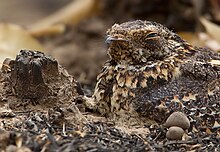Standard-winged nightjar
| Standard-winged nightjar | |
|---|---|

| |
| Male | |

| |
| Non-breeding | |
| Scientific classification | |
| Domain: | Eukaryota |
| Kingdom: | Animalia |
| Phylum: | Chordata |
| Class: | Aves |
| Clade: | Strisores |
| Order: | Caprimulgiformes |
| Family: | Caprimulgidae |
| Genus: | Caprimulgus |
| Species: | C. longipennis
|
| Binomial name | |
| Caprimulgus longipennis Shaw, 1796
| |

| |
| Range map of Caprimulgus longipennis, breeding range marked as dark and non-breeding range marked as light | |
The standard-winged nightjar (Caprimulgus longipennis) is a nocturnal bird in the nightjar family.
Distribution and habitat
[edit]It is a resident breeder in Africa from Senegal east to Ethiopia. It is found in dry savannah habitats, with some scrub.[2]
Description
[edit]The adult male has a bizarre and unusual wing ornament during the breeding season which consists of a broad central flight feather on each wing elongated to 38 centimetres (15 in), much longer than the bird's body. 20 centimetres (7.9 in) or more of this is bare shaft. In normal flight, these feathers trail behind, but in display flight they are raised vertically like standards. Outside the breeding season, there are no plumage distinctions between the male and female.
When roosting on the ground during the day, this medium-sized (20–23 centimetres (7.9–9.1 in) long) nightjar is mainly variegated grey, with a browner collar. It is a shadowy form with easy, silent moth-like flight; this nightjar is relatively short-tailed, and lacks white in the wings or tail. The song is a churring trill.[1]
Behaviour
[edit]
Like other nightjars, the standard-winged nightjar feeds on insects in flight, the huge gape opening wide for moths and beetles. It flies at dusk, most often at sundown, and can sometimes be seen with flying foxes.
No nest is made; in each clutch, two elliptical, slightly glossy eggs are placed upon bare sandy soil.[3]
Nomenclature
[edit]Though the standard-winged nightjar was originally placed in the genus Caprimulgus as in its first identification by George Shaw in 1796,[4] it was later placed in the genus Macrodipteryx along with the pennant-winged nightjar.[3] A phylogenetic study done in 2010[5] indicated that the two species were better placed within Caprimulgus, and that the species are closely related[3] despite having different morphology, breeding ranges, and breeding seasons.[6]
References
[edit]- ^ a b BirdLife International (2016). "Caprimulgus longipennis". IUCN Red List of Threatened Species. 2016: e.T22690021A93257600. doi:10.2305/IUCN.UK.2016-3.RLTS.T22690021A93257600.en. Retrieved 12 November 2021.
- ^ "Standard-winged Nightjar (Caprimulgus longipennis) | HBW Alive". Hbw.com. Retrieved 2019-07-22.
- ^ a b c Cleere, N.; Kirwan, G. M. (2020). del Hoyo, J.; Elliott, A.; Sargatal, J.; Christie, D. A.; de Juana, E. (eds.). "Standard-winged Nightjar (Caprimulgus longipennis), version 1.0". Birds of the World Online. Cornell Lab of Ornithology, Ithaca, NY. doi:10.2173/bow.stwnig1.01.
- ^ Shaw, George; Nodder, Frederick Polydore (1797). "The Leona Goatsucker, Caprimulgus longipennis (Pl. 265)". The Naturalist's Miscellany (in Latin). 8 (LXXXIX). doi:10.5962/p.310808.
- ^ Han, Kin-Lan; Robbins, Mark B.; Braun, Michael J. (May 2010). "A multi-gene estimate of phylogeny in the nightjars and nighthawks (Caprimulgidae)". Molecular Phylogenetics and Evolution. 55 (2): 443–453. doi:10.1016/j.ympev.2010.01.023.
- ^ Maclean, G. L. (1997). "Pennant-winged Nightjar". In Harrison, J. A.; Allan, D. G.; Underhill, L. G.; Herremans, Marc; Parker, V. (eds.). The atlas of Southern African birds. Randburg, South Africa: Acorn Books and Russel Friedman Books, in association with the Trustees of the John Voelcker Bird Book Fund. ISBN 978-0-620-20729-4.

